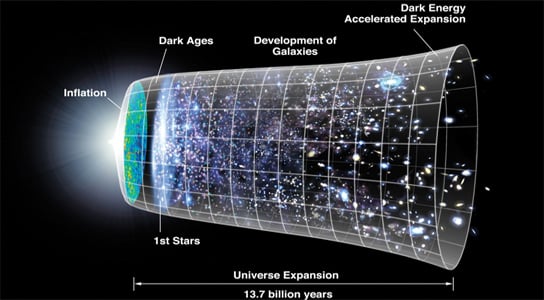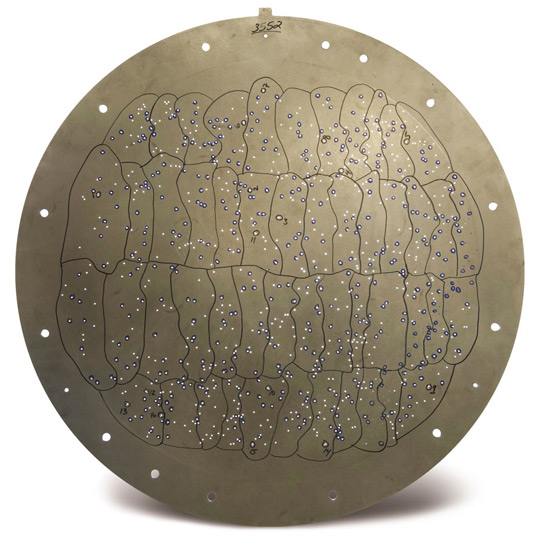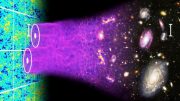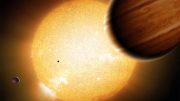
The Baryon Oscillation Spectroscopic Survey (BOSS) revealed its initial findings from 470,000 galaxies. Credit: NASA
One of nature’s biggest mysteries, dark energy, is being explored thanks to a deceptively simple tool that David Schlegel came up with. 2,200 aluminum plates, about the size of a manhole cover, each one drilled with a specific pattern of holes that match the arrangement of galaxies in a particular section of the sky, are used for an hour each at the prime focus of the 2.5-meter telescope at Apache Point Observatory in New Mexico. When the telescope points to the right spot, the light from each galaxy streams through its corresponding hole. This light is then broken up and used to measure how fast each galaxy is being carried away.

Credit: NASA
The study began in 2009 and will gather data from 1.5 million galaxies in an attempt to measure dark energy, a phenomenon thought to drive the Universe to expand at an ever-increasing rate, and determine whether its influence has remained constant or has varied over the last few billion years. The more galaxies that are measured in this fashion, the better the results.
Schlegel, an astronomer at the Lawrence Berkeley National Laboratory (LBNL) in California and principal investigator of this undertaking, which is known as the Baryon Oscillation Spectroscopic Survey (BOSS), unveiled their initial findings from 470,000 galaxies at the meeting of the American Astronomical Society in Austin, Texas.
The data has given a glimpse of the cosmic structure by demonstrating where galaxies clump together. This structure is a relic of a much younger and smaller Universe, one in which acoustic waves reverberated throughout the dense, hot plasma which hadn’t cooled enough to form stars and galaxies. These waves are called baryon acoustic oscillations (BAOs) and pushed matter into regions of high and low concentrations, with fairly even spacing, a pattern which evolved in later epochs into the giant sheets and filaments of galaxies that flourish in the Universe.

Credit: NASA
The spacing between these structures was first detected in 2005 and it has grown to about 150 megaparsecs (500 million light-years.) This natural cosmic yardstick offers BOSS the chance to detect the slightest deviations and offers the tightest constraint yet on dark energy’s influence. Surveys of Type Ia supernovae offered the first clues to dark energy in 1998. All of these Type Ia supernovae are thought to reach roughly the same peak of brightness, allowing them to be used as a standard way of determining the distance to their host galaxies.
These Type Ia supernovae also revealed that the expansion of the Universe is accelerating, rather than slowing down under gravity. One possible explanation is that dark energy is a cosmological constant, a repulsive outward pressure that is innate to the vacuum of space. BOSS hopes to narrow the uncertainty bounds of this model to a few percent.
The BOSS team has set its sights on BigBOSS, a survey that would sample 20 million galaxies up to 3.1 million parsecs away, along with 4 million quasars. This would allow to trace the influence of dark energy across most of cosmic history and to determine whether it has really remained a constant.
BigBOSS will rely on an automated system that will maneuver fiber tips into the precise positions needed to gather light from distant galaxies. The $70-million proposal was submitted to the National Optical Astronomy Observatory, which entails upgrading the 4-meter Mayall telescope on Kitt Peak in Arizona and begin 5 years of observing in 2018.
BigBOSS is a lot cheaper than NASA’s proposed $1.6-billion Wide-Field Infrared Survey Telescope. Dark energy could also be a change in general relativity at large scales or an indication that something strange is going on with gravity. Whatever the explanation is, these surveys will undoubtedly discover something worthwhile.









“Dark Energy” is hidden in plain sight, it is Momentum energy cmV = cP !
Momentum energy is not seen because physics defines energy as a scalar, not a vector. The Universe is made of Quaternions the sum of a scalar enrgy and a vector energy W = -mGM/r + cP.
The so-called “cosmological Constant” is the centrifugal force , the Divergence of cP, cDEL.P = -cp/r cos(P). This centrifugal force balances the centrifugal force -mGM/r2=vp/r. When they balance vp/r = cp/r cos(P) gives v/c=cos(P) this is the red shift. The red shift is an indicator of the centripetal force or gravitational attraction rather than expansion.
The earth has a red shift v/c= 30k/300m =cos(P) the angle of P is 89 59′ 39″.
The Universe is Static in that the first derivative is zero at the condition v=c. This is the Equilibrium Condition.
Matter creates a vector field v= Square-root(GM/r). Matter does not warp space as called for in GR. The Universe is finite in power, energy and size.